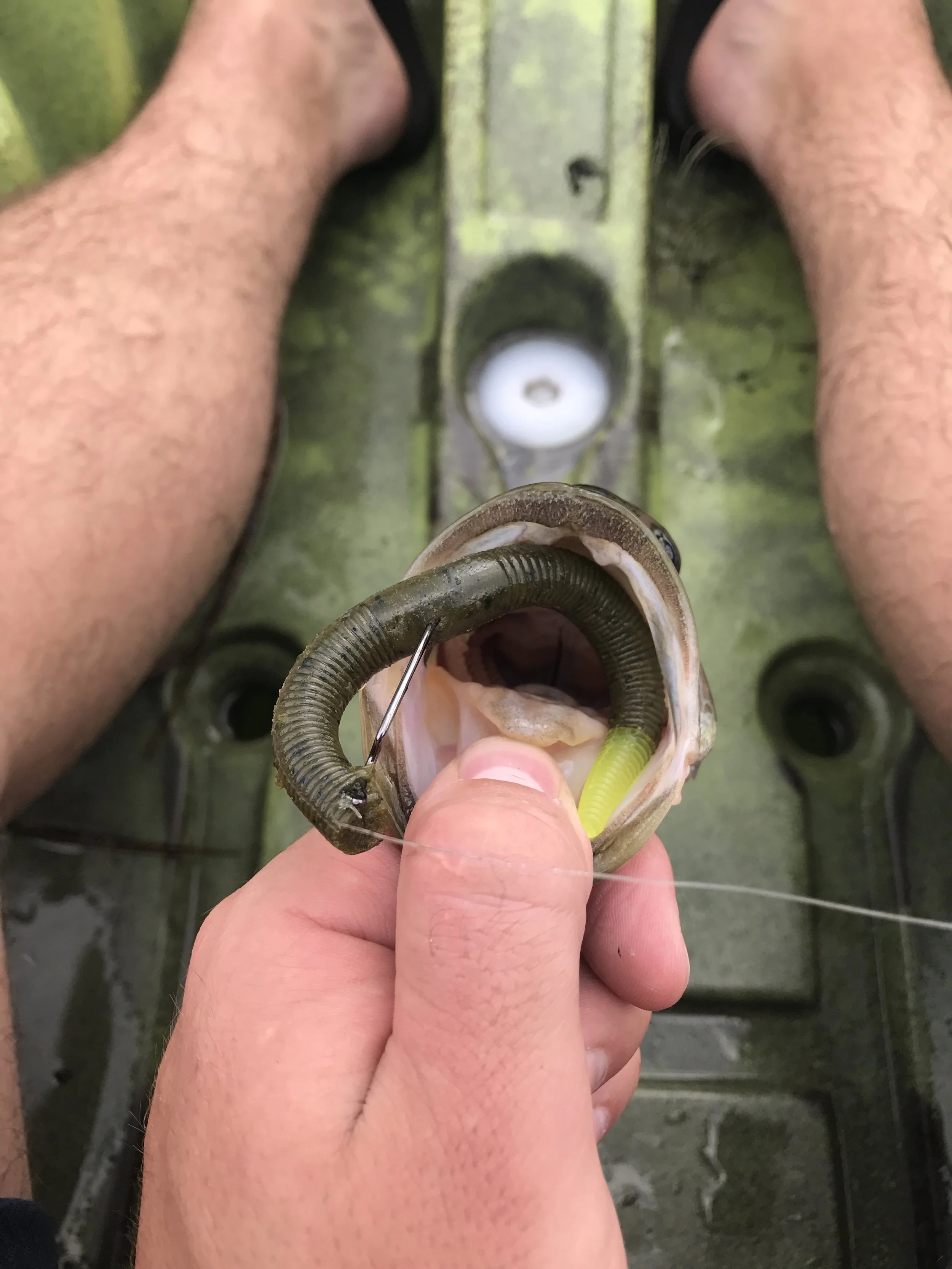We’re in the dog days of summer now. The last four weeks have been some of the most inhospitable fishing conditions I’ve seen in years; intermittent thunder storms, rain squalls, and bright sunshine occurred daily, with only a few consistent days of good or bad weather. The fishing has been about as tough as I’ve ever seen; some days you can fish before, during, and after a front within a matter of hours. Barometric pressure is rising and falling like the tide, lightening has kept me off the water several times, and the fish are very finnicky.
Two Sunday’s ago, I managed to take advantage of the crummy situation. I arrived at the lake with several hours to go before the weather predicted yet another big squall, and with nearly 18 hours having passed since the previous one, this was an excellent window to develop a pattern. Here’s how I did it.
I started off by hugging the shoreline in the kayak, with a shallow-running crankbait (.5 - 2ft.), a weedless 3.8in. belly-weighted Keitech and a stickbait tied up. Following my standard summer bass pattern as established in the previous post, I worked the shoreline and grass flats with those three baits, primarily going between the swimbait and the stickbait to keep weeds off my hooks and cover the most water in the smallest amount of time.
Colors I was working with at first were natural greens and darker colors, running Bluegill Flash on the Keitech and Ozark Shadow on the Yum Dinger. With the water blown out in most places, I needed something natural, but a color that would still contrast well in the limited sunlight and brackish shallows.
I worked those two baits for about an hour, maybe more, with not even a nibble. I switched colors on the Yum several times, trying Green-Pumpkin, Black and Blue Flake, Ozark Smoke – basically ever color I had on me at the time. No bites. About 100 yards along the shore from the grass lines I was fishing was a pocket that I knew wouldn’t have any submerged vegetation, at least at the depth my preferred crankbait would be running at. I decided to head on over and throw my Black-Back Chartreuse shallow diver from Strike King, seeing as the wind was picking up a bit now as the next wave of the storm front approached. The crankbait gave me my first clue.
A few casts in, nearly two full hours into the fishing trip, I hooked up on my first bass. She was a dink, by every definition of the word, but man was I ever happy to see her. Knowing that I didn’t have much time to work with, sitting in bright sunshine but with the storm of death looming on the Western horizon, I decided to take this single clue and throw the rest of my day at developing a pattern on something involving chartreuse. Packing up, switching stickbaits to the trusty Green-Pumpkin Chartreuse plasma-tail and hauling across the whole lake to my favorite stretch of shore, I backed myself into a sub-30-minute window to slam bass.
It didn’t take long for me to figure out that I’d wasted 2.5 hours throwing every other color in my box. Within three casts to a submerged branch, boom, a little largemouth came up and inhaled the worm. I tossed him back and cast out about 15 yards from the shore, in around 8-12 feet of water with lots of submerged vegetation, and boom, another little guy, but still another fish. The pattern continued for about 10 minutes, netting five little bass, all on the same worm. This was also my first real day spent with the Origin One 3 by 13 Fishing, a new casting reel with a blazing fast 8.0:1 gear ratio, but that’s really neither here nor there. The last fish I caught, quite literally before the wind blew me off the water, was an easy three-pounder, caught above a series of large rocks submerged around three feet below the surface. It was a terrific fight, particularly as the first big fish on a new reel.
The big girl proved to me that, at least in some sense, I developed a pattern and executed on it, but I do believe that it may have been a combination of factors that let me catch all of those fish. With the front blowing in, I think that the bass were likely up and feeding aggressively before the water absolutely blew out again. The bite turning on so furiously in such a short time frame supports that thought. Whether it was the color of worm, the feeding frenzy caused by changes in pressure and the incoming front, or simply being in the right place at the right time, it doesn’t really matter – I slammed them that day, and learned some lessons while doing it.



